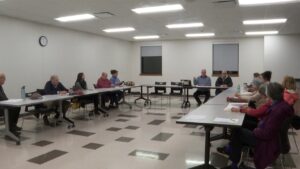Last night at the conference was the lovely prime rib dinner and a keynote talk by Leila Philips. I’m told that the Martinez beavers were mentioned by both Mike and Brock and I’m sure many exciting things happened that we’ll hear about eventually. In the meantime there was a great article about Human Beaver Coexistence from Maryland that I know you want to see.
A beaver champion in Virginia and the need for more like her
 Which brings me to Alison Zak, a Northern Virginia resident who operates, all by herself, the Human-Beaver Coexistence Fund, worthy of your interest and support. We need more like her throughout the 64,000-square-mile Chesapeake watershed facilitating beavers, the most charismatic link to water quality I know of.
Which brings me to Alison Zak, a Northern Virginia resident who operates, all by herself, the Human-Beaver Coexistence Fund, worthy of your interest and support. We need more like her throughout the 64,000-square-mile Chesapeake watershed facilitating beavers, the most charismatic link to water quality I know of.
“You can’t conserve wildlife without understanding and working with the people who will interact with that wildlife,” Zak said.
As she’s talking, we’re knee deep in the chilly swamp headwaters of Maryland’s Magothy River, a Bay tributary where she showed locals how to chew-proof an assortment of streamside maples, oaks and gums they didn’t want taken down by beavers.
An anthropologist by training, Zak, a Florida native, was living not so long ago on Sulawesi Island in Indonesia, studying seven endangered species of macaque monkeys. Having decided against years’ more research for a Ph.D., she migrated to environmental education work in Virginia’s Fauquier County.
There, she encountered wild beavers for the first time and became fascinated — or, she admits, “obsessed” with the animal. Landowners began to seek her advice on their beaver interactions.
“Most didn’t know much about them. They just knew this animal had shown up and [was] changing their property … flooding, chewing … that’s what beavers do.”
Alison is the coordinator of the beaver education group I meet with every month. She also just published a book on animal Yoga which fully proves there are all kinds of beaver supporters in the world.
 In 2021, she founded the Human-Beaver effort, working on coexistence projects from West Virginia to the Magothy — “anywhere I can reasonably drive.”
In 2021, she founded the Human-Beaver effort, working on coexistence projects from West Virginia to the Magothy — “anywhere I can reasonably drive.”
She is close to becoming a bona fide “beaver professional,” a certification offered by the Beaver Institute in Southampton, MA. Tuition is $2,500 and requires roughly 60 hours of online coursework, plus completion of four field projects.
These mostly work on the flooding issues that result when beavers impound water, which they do for their own safety, avoiding predators in the depths of their pond. In more than 90% of cases, Zak said, there are viable nonlethal solutions.
Easily maintained low-tech “flow devices,” for instance, can keep water deep enough for the beavers while preventing flooding. Where beavers block road culverts, a common issue, the solution is either flow devices or “beaver dam analogs” — human-made dams that encourage the rodents to relocate their own dams away from the culvert.
Engaging landowners and highway departments (for culverts) depends a lot on education, Zak said. “Because beavers are just now slowly rebounding after being gone so long [trapped out of the Chesapeake by mid-1700s], there’s a sort of ecological amnesia … A true beaver wetland to most of us looks like chaos. Single-channel streams spreading out to multiple channels, dead and dying trees, unruly vegetation.”
Her work usually begins with relationship building, understanding the landowners’ values and points of view. As for trappers, “I don’t vilify them,” she said. “They know a lot about beavers.”
Well she’s young and idealistic. She should be. She has years before she turns into a gnarled and battle scarred old advocate like me, right?
“We’re on the right trajectory. Beaver consciousness is growing. There are several good books out there,” she said, referring to Ben Goldfarb’s Eager — the Surprising Secret Life of Beavers and Why They Matter (2018) and Leila Philip’s more recent Beaverland — How One Weird Rodent Made America (2022).
She says real promise lies in working with trappers, who are frequently a landowner’s go-to when beavers arrive. “How can we make it lucrative for them to offer nonlethal solutions?”
Promise also lies with highway departments who must deal (often harshly) with beavers blocking highway culverts. In both instances, coexistence is a cheaper solution than constantly trapping or tearing out dams every year.
Solutions also need to be more regional, she said, because as beaver populations grow, new generations move upstream or to other streams.
Where we wade in the upper Magothy exemplifies the need for a more comprehensive approach. The beaver dam there gets torn down every spring by fisheries biologists, worried that threatened yellow perch can’t migrate farther upstream to spawn.
A simple solution, Zak thinks, would be to induce the beavers to dam outside a concrete culvert there, allowing easier dam bypass for the perch.
The Beaver Institute has trained more than 80 people nationwide to do what Zak does and is looking for more recruits.
So how about this as a new Bay restoration goal: at least one trained beaver problem-solver in every government environmental and transportation agency, as well as every environmental nonprofit?
I would like 5 of you in










































